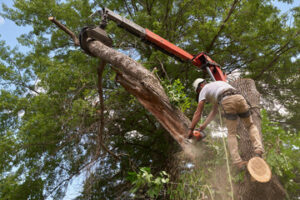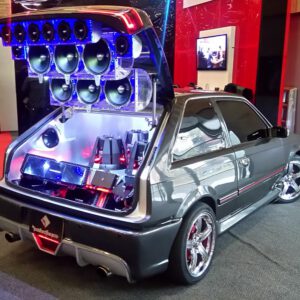Round Rock Tree Trimming is essential for the health of your landscape. It helps reduce safety hazards and maintain the shape and beauty of your plants.

Proper pruning also stimulates growth and alleviates overcrowded bushes that block sunlight and hinder growth. This article will cover pruning techniques for trees, shrubs, and hedges.
A tree needs to be pruned for a variety of reasons, from shaping its shape to removing dead or damaged branches. It’s important to know the right techniques for pruning so you don’t change the way a tree grows or encourage disease spread with improper cuts. Incorrect techniques can scar a tree or shrub for many years and lead to weakening and rot.
Proper pruning promotes healthy trees and helps them maintain their natural shape while preventing damage from storms or snow. To reduce the risk of damage, your landscape professional may use a combination of the following pruning techniques:
Remove unwanted or hazardous branches. The first step in any pruning process is to remove limbs that are dead, diseased, or damaged. These limbs are an invitation to insects and pathogens, as well as a safety hazard.
Removing these limbs helps to prevent damage during storms and protect your home. It also allows sunlight to reach lower branches, encouraging branching and fruit production.
Shorten or “open” the crown. This involves removing a few select branches to help light or air flow through the canopy. This should be done gradually over the course of a few years to avoid reducing the strength of a tree.
Removing the stubs of previous pruning cuts: When a twig or branch is removed from a plant, it should be cut away at a point above a bud or branch that points outward. This is called a “collar cut” and results in a much smaller wound than a cut that is made parallel (flush) with the trunk. Cutting a stub close to the trunk or supporting stem interferes with the tree’s ability to seal the pruning wound and can lead to dieback.
Study the plant’s form. This is often done by selecting scaffold branches that are properly spaced and positioned around the main stem. Properly selected scaffold branches should have good vertical and radial spacing on the trunk. Branches with narrow-angle crotches should be removed as they are weaker and subject to wind damage.
Equipment
When trimming a tree, it is important to use the right equipment. A variety of hand tools and power tools can be used for the task, including shears, loppers, pole pruners, and chainsaws. Some of these tools may be used for both pruning and trimming, while others are better suited for specific purposes.
For example, hand shears are typically used for smaller branches and twigs. Larger shears, such as loppers, feature long handles and can cut through stems up to three-quarters of an inch in diameter. They can also be used to trim hedges and shape shrubs. Some of these shears have straight blades, while others have curved ones.
A curved blade is ideal for cutting thick stems and branches, while a straight blade works best with soft stems and leaves. Some shears fold down into a compact design for easy storage, while others have a longer handle that increases leverage and comfort.
The type of shears a professional uses depends on the size and thickness of the branches being cut. A basic set of hand shears is a good choice, but if the job calls for more specialized cutters, the professional should invest in them. A pair of safety goggles is also a must, as the task can result in bits of wood and sawdust flying into the eyes. A hard hat is another useful piece of equipment that protects the head from impact and other injuries while trimming trees.
In addition to the proper equipment, a tree professional should carry a first aid kit for any accidental wounds during the course of a trimming job. A small kit should include items such as bandages, a sterile pad, and antiseptic wipes. It is recommended that the kit be attached to a belt or harness to make it easily accessible.
If the job is to be performed near a street, traffic cones are essential to help direct pedestrians and cars away from the work area. A tarp is also an excellent option to help keep the working area clean and protected. Finally, a protective mat helps disperse the weight of the equipment and reduce the risk of damage to delicate lawns and paved areas.
Safety
Tree trimming is dangerous work, and employees need to be properly trained for the job before it begins. Employees should always wear personal protective equipment (PPE), such as gloves, safety goggles, and hard hats, and use safe work practices when climbing and cutting trees. It’s also important to read and follow the directions on all climbing and trimming equipment before using it.
It’s also a good idea to have an experienced tree trimming specialist conduct an inspection before starting work on the ground or in a tree. This will help identify potential hazards, such as the presence of power lines or limbs that may fall during a storm. The tree trimmer should then mark the area around the tree to prevent bystander access and work with another person who stays on the ground.
Besides improving the overall health of your trees, tree trimming can also enhance the appearance of your property. Unhealthy, drooping, or dead branches are unsightly and can cause damage during a storm or high winds. Keeping your trees healthy and attractive with regular pruning is more cost-effective than fixing or replacing damaged branches and leaves.
Additionally, a well-maintained tree canopy allows more sunlight to reach the ground and other vegetation beneath it. This can promote growth in lawns, gardens, and other landscaping features on your property.
Finally, tree trimming can prevent rodents from accessing your home through small gaps in the trees surrounding it. This can be a problem for homeowners who entertain guests or plan on selling their homes in the future.
Performing tree trimming can be very dangerous, especially when working near electric wires. If a worker contacts an energized line, they could be seriously injured or even killed. It’s essential to have an experienced professional perform any electrical-related tasks, such as the trimming and removal of large sections of a tree. If you do choose to trim or remove a tree yourself, make sure that the electric line is completely de-energized and never climb a ladder close to an overhead power line. You should also wear personal protective equipment and follow the safety protocols set forth by OSHA.
Time of year
A tree’s or shrub’s health and appearance are directly tied to how often its branches are trimmed. Incorrect pruning can stunt a plant’s growth, weaken its structure, and leave it vulnerable to pests or disease. Whether you want to boost flower production, optimize fruit yields, or just achieve a more balanced look, trimming is an important part of any landscape maintenance routine.
When you prune a plant, the cutting site will be surrounded by living tissue that’s designed to seal over the wound. This protective tissue is made of special cells that are activated by a tree’s natural chemicals to start the healing process, much like our bodies react to cuts and injuries. If a tree is pruned at the wrong time of year, it can lose its ability to heal these wounds and may begin to deplete its energy reserves.
For this reason, many shade and ornamental trees are best trimmed in the winter or early spring while they’re dormant. This allows the plants to sink all of their energy into healthy new growth once the weather warms up again.
There are some exceptions to the rule, however. Some trees, such as birches or elms, can only be trimmed in the fall when they’re dormant. This helps them avoid absorbing extra moisture during the warmer months and sustaining water damage that could result in dieback or other health issues.
Depending on the species of your garden or yard trees, you can also determine when it’s most beneficial to prune them based on their blooming seasons. Certain flowering plants, such as azaleas, beautybush, bridalwreath spirea, clematis, lilacs, tulips, and forsythia, bloom on old wood that stays dormant through the winter and emerges again in spring. If you prune these plants too soon, you’ll cut off the buds that would have bloomed this year.
During the winter, snow can pile up on weakened limbs and cause them to snap. In addition to potentially damaging your property, these broken limbs can also create dangerous hazards for pedestrians and vehicles. By scheduling a tree trimming service in the winter, you’ll eliminate these safety risks and prevent costly damage to your outdoor plants.
